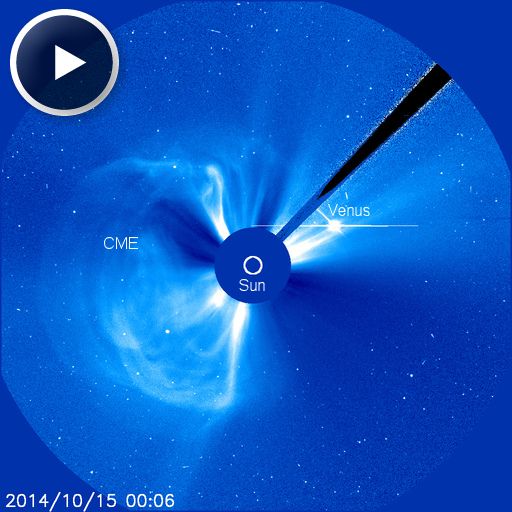On October 23rd there will be a partial eclipse of the Sun. Got clouds? No problem. The event will be broadcast live on the web by the Coca-Cola Science Center. | | | AURORAS ON MARS: This Sunday, Oct. 19th, Comet Siding Spring will pass only 140,000 km from Mars. The encounter is so close, the atmosphere of the comet could brush against the atmosphere of the planet. Will this spark auroras on Mars? A video from NASA weighs the odds of some very strange space weather. AURORAS ON EARTH: A CME sideswiped Earth's magnetic field on Oct. 14th. Shortly thereafter, Earth passed through a fold in the heliospheric current sheet (a "solar sector boundary crossing"). The combined effect was to ignite a spectacular light show around the Arctic Circle. "Auroras were running across the sky as soon as the daylight faded," reports Frank Olsen who sends this picture from Sortland, Norway: 
"The display lasted for more than 10 hours, and was still going on at 5 am Norwegian time on Oct. 15th," continues Olsen. "This night has been awesome!" Arctic sky watchers should remain alert for auroras on Oct. 15-16. Earth's magnetic field is still reverberating from the CME strike and the solar sector boundary crossing. NOAA forecasters estimate a whopping 50% chance of polar geomagnetic storms during the next 24 hours. Aurora alerts: text, voice Realtime Aurora Photo Gallery FARSIDE EXPLOSION: A sunspot capable of powerful eruptions is about to rotate onto the Earthside of the sun. It announced itself on Oct. 14th by hurling a spectacular CME over the sun's southeastern limb: 
The underlying explosion was hidden behind the southeastern edge of the sun. Even in eclipse, however, the blast registered M2 on the Richter Scale of Solar Flares. The actual rating must have been must higher, perhaps even X-class. NASA's Solar Dynamics Observatory recorded an extreme ultraviolet movie of debris flying over the sun's limb: 
Within a few days,the blast site should emerge over the limb where we can see it from Earth. Then analysts can examine its magnetic field and evaluate the potential for future eruptions. Stay tuned. Solar flare alerts: text, voice Realtime Space Weather Photo Gallery
Realtime Comet Photo Gallery
Realtime Eclipse Photo Gallery
Every night, a network of NASA all-sky cameras scans the skies above the United States for meteoritic fireballs. Automated software maintained by NASA's Meteoroid Environment Office calculates their orbits, velocity, penetration depth in Earth's atmosphere and many other characteristics. Daily results are presented here on Spaceweather.com. On Oct. 15, 2014, the network reported 30 fireballs.
(24 sporadics, 2 October Ursae Majorids, 2 Southern Taurids, 1 epsilon Geminid, 1 chi Taurid)  In this diagram of the inner solar system, all of the fireball orbits intersect at a single point--Earth. The orbits are color-coded by velocity, from slow (red) to fast (blue). [Larger image] [movies] Potentially Hazardous Asteroids ( PHAs) are space rocks larger than approximately 100m that can come closer to Earth than 0.05 AU. None of the known PHAs is on a collision course with our planet, although astronomers are finding new ones all the time. On October 15, 2014 there were 1507 potentially hazardous asteroids. Notes: LD means "Lunar Distance." 1 LD = 384,401 km, the distance between Earth and the Moon. 1 LD also equals 0.00256 AU. MAG is the visual magnitude of the asteroid on the date of closest approach. | | The official U.S. government space weather bureau | | | The first place to look for information about sundogs, pillars, rainbows and related phenomena. | | | Researchers call it a "Hubble for the sun." SDO is the most advanced solar observatory ever. | | | 3D views of the sun from NASA's Solar and Terrestrial Relations Observatory | | | Realtime and archival images of the Sun from SOHO. | | | from the NOAA Space Environment Center | | | the underlying science of space weather | | 
